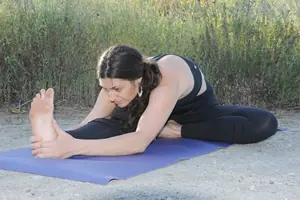Bloating, cramping, headaches, nausea—sound familiar ladies? It's that time of the month, and indulging in cravings like salt, sweets, caffeine or alcohol may feel nurturing at that moment, but it's not. Instead, seek out other options to ease monthly aches and pains.
Uterus contractions cause much of the pain felt during the menstrual cycle because the contractions inhibit blood flow to the lining of the uterus. Abdominal cramps, low-back pain and leg discomfort are common symptoms. Taking pain medicine can help but only temporarily. It simply masks the pain instead of addressing the root of the challenge.
Eat fruits and vegetables, exercise regularly, and reduce stress to help alleviate menstrual pain. Yoga, acupuncture, acupressure and other relaxation therapies are recommended treatments.
Here are four yoga poses that will help relax the nervous system, relieve low-back pain, reduce leg and abdominal aches, calm your emotions, and ease other menstrual discomforts.
More: What Causes Menstrual Cramps
1. Janu Sirsasana A: Head-To-Knee Forward Bend

Start on the floor in a seated position with your legs extended forward. Bend the right knee outward to a 90-degree angle and press the right foot into the inner left thigh. Grab the left shin or foot, inhale, square the hips, and lengthen the torso over the straight leg.
Exhale, fold forward slowly from the groins. Extend the spine and lengthen through the chest. Allow your back to lengthen instead of round.
Pull your left toes back towards you and extend through the left heel while firmly pressing the right foot into the left thigh. Press your sit bones down towards the floor. Continue to breathe steadily while gazing at the left foot. Stay in this pose for 1 to 3 minutes and then switch sides.
Benefits:
- Stretches the spine, shoulders, hamstrings and groin.
- Calms the brain and helps relieve mild depression.
- Reduces anxiety, fatigue, headache and menstrual discomfort.
More: 7 Reasons Why You Should Practice Yoga
2. Pasasana: Noose Pose

Come into a full squat position with you feet together; lower your buttocks down towards your heels. If your heels don't reach the floor, place a folded blanket underneath.
Inhale and swing your knees to your left as you turn your torso to the right. Exhale, reach the back of your upper left arm around the outside of your right leg and reach the left forearm in front of the legs to wrap back behind the left leg.
Take a breath in and move the right arm behind your low back to clasp the hands. Exhale. Open the chest and gaze over the right shoulder. Keep the hips squared and your knees parallel to one another facing forward. Breathe steadily for 30 to 60 seconds. Inhale, gaze back to center, and exhale to release. Switch sides.
Modification: Squat down with the feet hip-distance apart and keep the feet parallel. Bring the back of the upper left arm to the inside of the left leg and wrap the left forearm behind the left leg. Reach the right arm behind the low back to clasp the hands. Twist to the right and gaze over the right shoulder. Breathe steadily for 30 to 60 seconds, and then switch sides.
Benefits:
- Stretches the thighs, groins and spine.
- Improves digestion.
- Relieves mild back, shoulder and neck tension.
- Alleviates indigestion, flatulence and menstrual discomfort.



